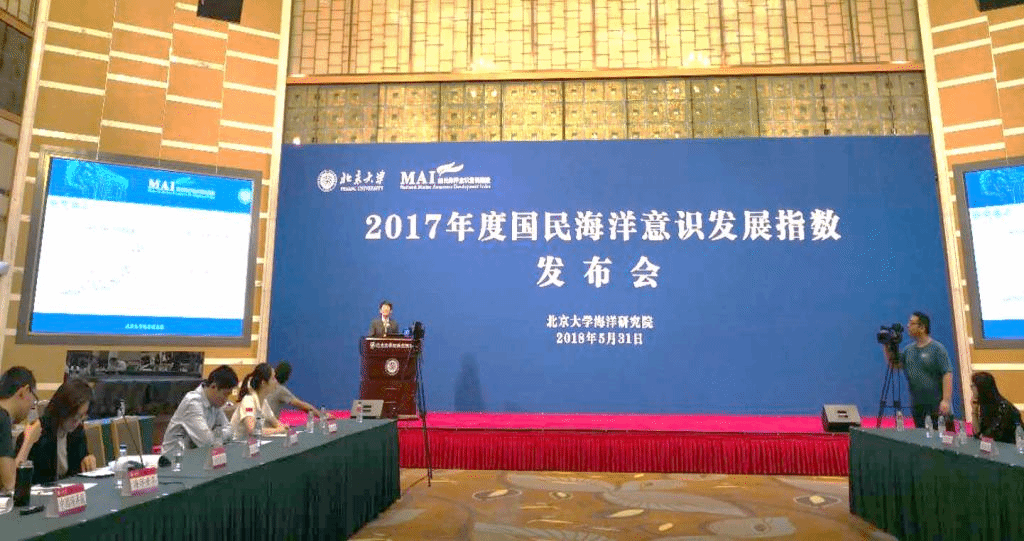
On May 31, 2018, National Marine Awareness Development Index (MAI) Research Report (2017) was published by the Institute of Ocean Research of Peking University. According to the report, the average score of Marine Awareness Development Index of China's provinces (regions and cities) in 2017 is 63.71, which is higher than that of 2016 (60.02), and nearly 80 percent of the provinces are above 60.

On-site press conference
The conference was hosted by Hu Bo, a research professor from Institute of Ocean Research, Peking University. Professor Wang Lei, vice dean of the institute, delivered an opening speech. He said, Peking University Institute of Ocean Research is an interdisciplinary research platform. We will actively contribute to the building of a strong maritime country, give full play to the role of think tanks in making suggestion to continuously assess the development of China's marine awareness. The Institute of Ocean Research are undertaking the research of the MAI.

From the left to right: Research Professor Hu Bo, Professor Wang Lei, Professor Wang Jimin
Professor Wang Jimin, director of the Marine Information Research Center of the institute, and leader of the research group of National Marine Awareness Development Index, gave a detailed report. He pointed out that on the basis of the 2016 study, the report optimized the evaluation index system and measurement method of national marine awareness, tracked and assessed the development of marine awareness in 31 provinces (regions and cities) in China based on Internet big data and offline survey data.
According to the assessment results, Beijing ranked first, Shanghai and Hainan ranked second and third respectively; the inland province of Shanxi performs well, ranking 9th; six coastal cities and provinces of Tianjin, Zhejiang, Jiangsu, Shandong, Guangdong and Fujian ranked in the top 10. Coastal provinces of Guangxi and Hebei scored low, ranking 18th and 19th respectively; the inland provinces of Tibet, Xinjiang, Guizhou, Yunnan, Qinghai, Gansu and Inner Mongolia ranked low, failing to meet the standard, while the remaining provinces all scored over 60 points. In general, China's National Marine Awareness Development Index score is still low, but compared with 2016, it has made significant progress. The promotion, education and cultural construction of marine awareness have gained remarkable achievements.
Professor Wang Jimin pointed out that among the 31 provinces (regions and cities) involved in the evaluation, 4 provinces scored above 70, 20 provinces scored between 60 and 70, 7 provinces scored less than 60. Most provinces were in the middle level after passing the "passing line" (i.e. 60) and these provinces often tend to have great potential. So the marine awareness of China can be continuously improved in the future. From the perspective of the regional distribution, the overall Marine Awareness Development Index of China still shows a trend of decreasing from coastal to inland. The mean score of the east, the northeast, the central and the western regions were 69.57, 61.61, 61.61, 60.41, which shows that the eastern region's score is much higher than other area, and even though the western region's score is the lowest, some provinces is relatively prominent. From the perspective of data sources, there are certain differences in the expression channels of people’s marine awareness in different provinces. People in western China have a strong demand for marine information, and the search score of Internet sea-related information is relatively outstanding; in some coastal provinces (such as Hebei), people have rich sea-related knowledge, and score high in offline questionnaire survey, but the score of sea-related information search is obviously weak. Although some inland provinces have a low score overall, they have a prominent performance in certain channels, such as Tibet, which has a relatively obvious microblog score.
The study also puts forward five suggestions for improving national marine awareness. First, sum up the experiences to enrich the toolbox of ocean awareness promotion and education. Second, design medium and long term development plan for different provinces. Third, combine the work of improving marine awareness with the overall development strategies of the country and the region. Fourth, use big data and other technologies to improve the accuracy of promotion and education work. Fifth, continuously monitor and keep abreast of the development of marine awareness.
In addition, the report also studied some special topics. In terms of ocean awareness index of the coastal cities, Shanghai, Qingdao, Tianjin, Xiamen, Dalian, Guangzhou, Shenzhen, Zhoushan, Ningbo and Sanya rank the top 10. In terms of the tourism heat index of coastal cities, Shanghai, Sanya, Qingdao, Xiamen, Guangzhou, Dalian, Shenzhen, Rizhao, Tianjin and Qinhuangdao rank the top 10. In terms of seafood index of coastal cities, Shanghai, Guangzhou, Shenzhen, Wenzhou, Qingdao, Dongguan, Ningbo, Taizhou, Xiamen and Yantai rank the top 10. In terms of marine patent index of provinces, Shandong, Jiangsu, Guangdong, Zhejiang, Beijing, Shanghai, Tianjin, Liaoning, Hubei and Guangxi rank among the top 10.
In the end, a number of journalists from GUANGMING RIBAO, China Daily, CCTV and other media raised questions on the significance of national marine awareness, the status of foreign studies and the assessment groups.